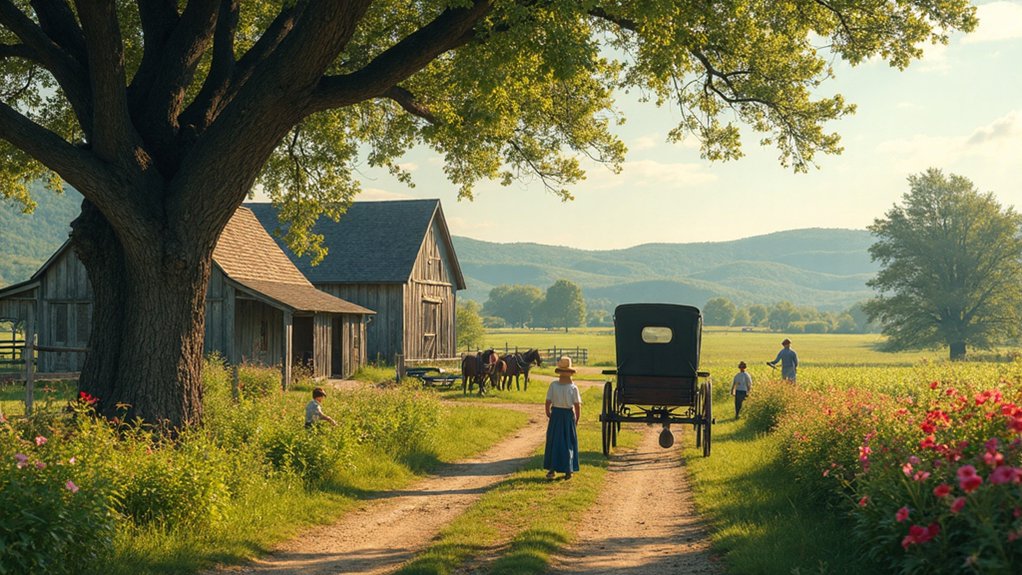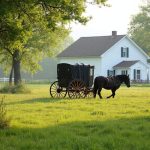
What religion do the Amish follow?
One might wonder about the Amish faith and its profound impact on their lifestyle, revealing intriguing beliefs and practices that invite deeper exploration.


When exploring the origins of Amish communities, you’ll discover a fascinating story rooted in faith, tradition, and resilience. The origins of Amish communities can be traced back to the Anabaptist movement in 16th-century Europe, where a desire for religious freedom set them apart.

Over time, the origins of Amish communities were shaped by their migration to North America, where they sought a peaceful life guided by their core beliefs. By understanding the origins of Amish communities, you gain insight into how their customs and values have endured and evolved, creating the close-knit societies we see today.
The Anabaptist movement in Europe began in the 16th century and played a major role in shaping the beliefs of groups like the Amish.
The Anabaptist movement in Europe focused on adult baptism, a practice that set its followers apart from many other Christian groups. Supporters of the Anabaptist movement in Europe also believed strongly in keeping church and state separate and living peaceful, nonviolent lives.
Because the Anabaptist movement in Europe faced heavy persecution, many members sought out new places where they could freely practice their faith.
Today, the influence of the Anabaptist movement in Europe can still be seen in communities that value religious freedom and simple living.
The Swiss Brethren played a crucial role as early Amish leaders, shaping the foundation of what would become the Amish faith.
These early Amish leaders emphasized adult baptism, nonviolence, and a strong sense of community living—values that remain central to Amish identity today.
Influential early Amish leaders such as Conrad Grebel and Felix Manz championed religious freedom and inspired many to join their movement.
Thanks to these early Amish leaders, the groundwork was laid for the Amish communities that continue to thrive in the modern world.
Migration to North America in the 18th century was a turning point for the Amish community.
During the 18th century, religious persecution in Europe forced many Amish families to look for a safer place to live. Migration to North America offered the Amish the chance to practice their faith freely and build new lives.
Most Amish migrants chose Pennsylvania as their destination, thanks to William Penn’s policies of religious tolerance.
This migration to North America in the 18th century helped the Amish establish strong, close-knit communities where they could preserve their traditions and values for generations to come.
Religious persecution played a major role in shaping the Amish communities we know today. The Amish faced severe religious persecution in Europe, which pushed them to search for a place where they could practice their faith without fear. This quest for freedom from religious persecution led the Amish to settle in North America.
Over time, their experiences with religious persecution helped build a strong sense of community and a commitment to simple living. Even today, the history of religious persecution continues to influence Amish values, encouraging them to focus on faith, togetherness, and a life apart from modern society.
When exploring Amish settlement patterns in Pennsylvania, you’ll see how Amish communities have been deeply influenced by the state’s geography and their strong community values.
Amish settlement patterns in Pennsylvania are especially visible in Lancaster County, where the fertile land made farming a central part of Amish life.
These Amish settlement patterns in Pennsylvania also show how close-knit villages developed, with homes and farms located near each other to encourage cooperation, support, and shared traditions.
This unique way of living highlights the Amish commitment to tradition, simplicity, and a strong connection to the land.
The influence of German and Swiss culture is deeply woven into the Amish way of life. This influence of German and Swiss culture is easy to see in the Amish language, traditions, and skilled craftsmanship.
For example, the Amish speak Pennsylvania Dutch, a dialect that highlights the influence of German and Swiss culture. Their strong community values and simple lifestyle also reflect customs passed down from these European roots.
Thanks to the influence of German and Swiss culture, the Amish have preserved a unique identity that stands strong, even in today’s modern world.
The formation of distinct Amish groups has a fascinating history rooted in German and Swiss traditions. Over time, the formation of distinct Amish groups has resulted in different beliefs, practices, and ways of life.
For example, the formation of distinct Amish groups has led to communities such as the Old Order Amish and the Beachy Amish, each with their own unique rules about faith, technology, and daily living.
These differences come from historical splits and the influence of different regions, helping to shape the rich diversity within the Amish world today.
If you visit Amish communities, you’ll quickly see how important Pennsylvania Dutch is to their way of life.
Pennsylvania Dutch is more than just a language—it’s a vital part of Amish culture and identity. This unique dialect, known as Pennsylvania Dutch, combines elements of German and English, connecting generations and preserving their traditions.
You’ll often hear Pennsylvania Dutch spoken in Amish homes and at community gatherings, helping to strengthen their close-knit culture and keep their heritage alive.
The Amish response to modernity involves careful consideration of which technologies fit their values and way of life. For example, the Amish response to modernity means they may use solar power for essential needs but often avoid modern conveniences like cars and smartphones.
This selective approach helps the Amish preserve their strong community bonds, focus on their faith, and continue their traditional lifestyle.
The preservation of traditional values is at the heart of Amish communities, shaping their daily lives and long-term outlook. Through the preservation of traditional values, families stay closely connected, and a strong sense of community flourishes.
Skills, customs, and religious beliefs are passed down from one generation to the next, ensuring the preservation of traditional values remains strong. Regular community gatherings and shared activities further reinforce these important beliefs, allowing the preservation of traditional values to thrive and keep Amish culture vibrant for future generations.
To sum up, the origins of Amish communities are rooted in a fascinating and enduring history. The origins of Amish communities trace back to the Anabaptist movement, which valued religious freedom and simplicity. Over the centuries, the origins of Amish communities have been marked by their migration to North America and their commitment to preserving traditional values.
Today, the origins of Amish communities continue to shape their unique way of life, allowing them to maintain their cultural heritage and pass their traditions on to future generations.

One might wonder about the Amish faith and its profound impact on their lifestyle, revealing intriguing beliefs and practices that invite deeper exploration.

Uncover the surprising truth about Amish property taxes in the USA and how these obligations impact their traditional way of life. What challenges do they face?

Many factors influence Amish participation in elections, but what hidden dynamics shape their unique political engagement? Discover the surprising elements at play.

Curious about where to find the largest Amish communities? Discover the hidden gems and traditions that await you in these unique enclaves.

Beneath the surface of commercialized Christmas lies the Amish way, where simplicity and spirituality reign—discover how their unique traditions celebrate faith and family.

Beneath the surface, alcohol use in communities reveals fascinating insights about culture and connection—discover the surprising facts that shape our social dynamics.